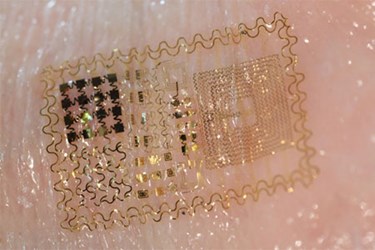'Electronic Skin' Enables Continuous, Accurate Patient Monitoring
By Sara Jerome,
@sarmje

Researchers have created an "electronic skin" that can take a patient's temperature — a potential indicator of underlying medical conditions — with less discomfort and more accuracy and functionality.
The skin "adheres non-invasively to human skin, conforms well to contours, and provides a detailed temperature map of any surface of the body," according to an announcement from the National Institute of Biomedical Imaging and Bioengineering, which participated in a study of the skin along with researchers from the University of Illinois at Urbana/Champaign.
The new technology is referred to as "epidermal electronics." It consists of "ultrathin, flexible skin-like arrays, which resemble a tattoo of a micro-circuit board," according to the institute.
The advantage? "The technology offers the potential for a wide range of diagnostic and therapeutic capabilities with little patient discomfort. For example, sensors can be incorporated that detect different metabolites of interest," the institute said.
The electronic skin can also be used to administer heat therapy to various regions of the body, or to deliver electrical pulses and specific drugs. Future versions could be wireless, used to transfer data, the institute said.
The researchers published their work in the journal Nature Materials. The study observed "subtle variations in skin temperature associated with mental activity, physical stimulation, and vasoconstriction/dilation along with accurate determination of skin hydration through measurements of thermal conductivity represent some important operational examples," according to the abstract.
In a report about epidermal electronics, Popular Science envisioned a future with this technology in use. "Someday soon, hospital patients won't be hooked up to wires and monitors — instead, electronic patches will be temporarily tattooed onto their bodies," it said. Patients wearing neck patches will be able to signal to robots, "who will translate throat muscle movements into simple speech," the report said.
The technology will allow doctors to check vital signs without poking at the patient. "The electronic tattoo achieves the mechanical properties of skin, which can stand up to twisting, poking, and pulling without breaking," the MIT Technology Review reported. The tattoo can stretch and shift with the skin when the patient moves.
Nanowerk noted that “previous work in medical thermal imaging has shown the utility of precision temperature mapping of human skin in the study of pathological conditions that affect how the body regulates temperature.” However, medical thermal imaging tends to be a pricy technology. It suffers from "the high cost of infrared cameras (>$100,000 for high-precision models), and the cameras struggle to measure curved or moving surfaces of living tissues," the article said.
"We hope that the technology developed leads to more new medical research and applications than we could hope to accomplish on our own," John Rogers of the University of Illinois at Urbana-Champaign, and the lead researcher on this topic, told Nanowerk.
Image Credit: Rogers Research Group, University of Illinois at Urbana-Champaign
